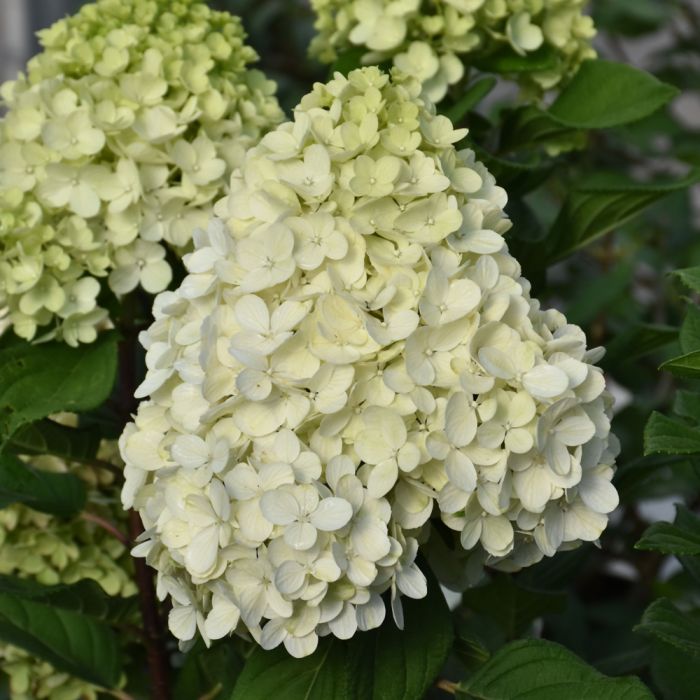Hydrangea, Panicle 'Little Lime Punch™'



Out of stock
Coming soon, still growing- Sun Preference
- Full-Sun, Part-Sun
Description
Compact habit that blooms profusely with flowers that emerge lime green, morphing to white, then light pink and finishing pomegranate red. All colors may be present at the same time on the same plant making for a spectacular show.
Minnesota's Largest Selection of Shrubs
Elevate your landscaping with Gertens' unmatched variety of shrubs! Selecting the right shrubs for your backyard can enhance its beauty and functionality. Consider factors like sunlight, soil type, and mature size when choosing shrubs. For sunny areas, flowering shrubs like roses or hydrangeas can add color and charm. In shady spots, opt for shrubs like azaleas or hostas. Evergreen shrubs provide year-round interest and privacy, while deciduous shrubs offer seasonal color changes. At Gertens, we offer a wide selection of shrubs to suit every backyard need.
Details
Little Lime Punch® Hydrangea | Hydrangea paniculata 'SMNHPH'
Height: 4 feet
Spread: 4 feet
Sunlight: Full Sun to Full Shade
Hardiness Zone: 3a
Brand: Proven Winners
Description:
This compact shrub with strong stems serves up color all season long; large, conical, lime green flower heads mature from the bottom up, to shades of white, light pink, then Hawaiian Punch red; the colors will mix on the same plant as it reblooms
Ornamental Features
Little Lime Punch® Hydrangea features bold conical lime green flowers with creamy white overtones and pink edges at the ends of the branches from early summer to mid fall. The flowers are excellent for cutting. It has green deciduous foliage. The textured pointy leaves do not develop any appreciable fall color.
Landscape Attributes
Little Lime Punch® Hydrangea is a multi-stemmed deciduous shrub with an upright spreading habit of growth. Its relatively coarse texture can be used to stand it apart from other landscape plants with finer foliage.
This shrub will require occasional maintenance and upkeep, and is best pruned in late winter once the threat of extreme cold has passed. It has no significant negative characteristics.
Little Lime Punch® Hydrangea is recommended for the following landscape applications;
- Accent
- Mass Planting
- General Garden Use
- Container Planting
Planting & Growing
Little Lime Punch® Hydrangea will grow to be about 4 feet tall at maturity, with a spread of 4 feet. It tends to be a little leggy, with a typical clearance of 1 foot from the ground. It grows at a medium rate, and under ideal conditions can be expected to live for 40 years or more.
This shrub performs well in both full sun and full shade. It prefers to grow in average to moist conditions, and shouldn't be allowed to dry out. To help this plant achive its best flowering performance, periodically apply a flower-boosting fertilizer from early spring through into the active growing season. It is not particular as to soil type or pH. It is highly tolerant of urban pollution and will even thrive in inner city environments. Consider applying a thick mulch around the root zone in both summer and winter to conserve soil moisture and protect it in exposed locations or colder microclimates. This is a selected variety of a species not originally from North America.
Little Lime Punch® Hydrangea makes a fine choice for the outdoor landscape, but it is also well-suited for use in outdoor pots and containers. With its upright habit of growth, it is best suited for use as a 'thriller' in the 'spiller-thriller-filler' container combination; plant it near the center of the pot, surrounded by smaller plants and those that spill over the edges. It is even sizeable enough that it can be grown alone in a suitable container. Note that when grown in a container, it may not perform exactly as indicated on the tag - this is to be expected. Also note that when growing plants in outdoor containers and baskets, they may require more frequent waterings than they would in the yard or garden. Be aware that in our climate, most plants cannot be expected to survive the winter if left in containers outdoors, and this plant is no exception. Contact our experts for more information on how to protect it over the winter months.
More Information
| Gerten Grown Plants | Gerten Grown Plants |
|---|---|
| Sun Preference | Full-Sun, Part-Sun |
| Mature Height (Range) | 2 - 5 feet |
| USDA Hardiness Zone | 3, 4, 5, 6, 7, 8 |
| Common Family Name | Hydrangea |


